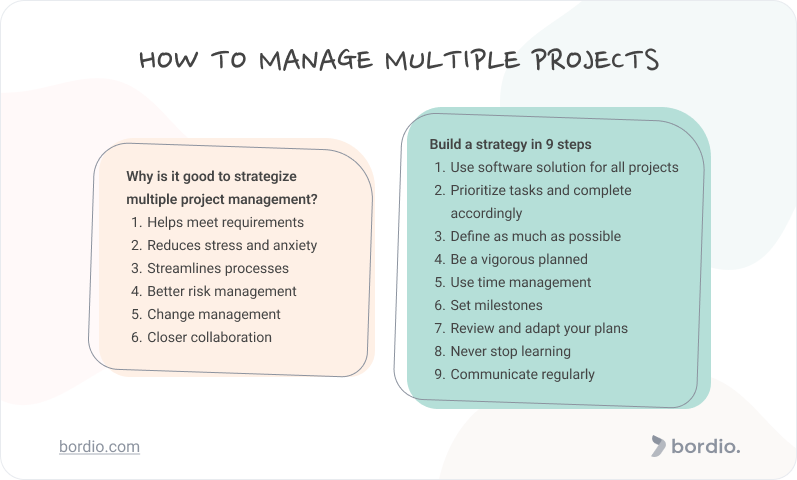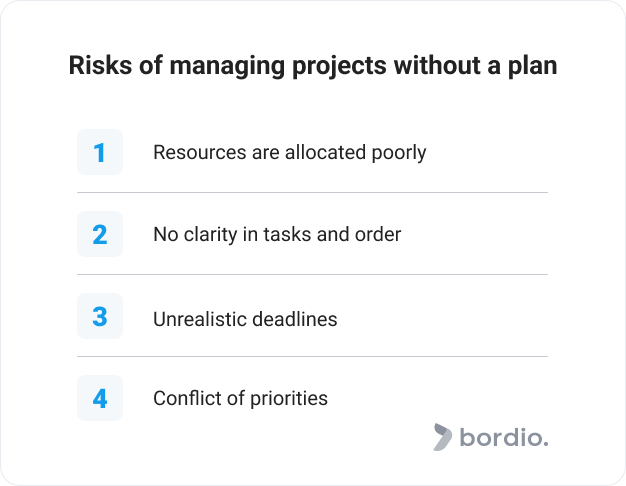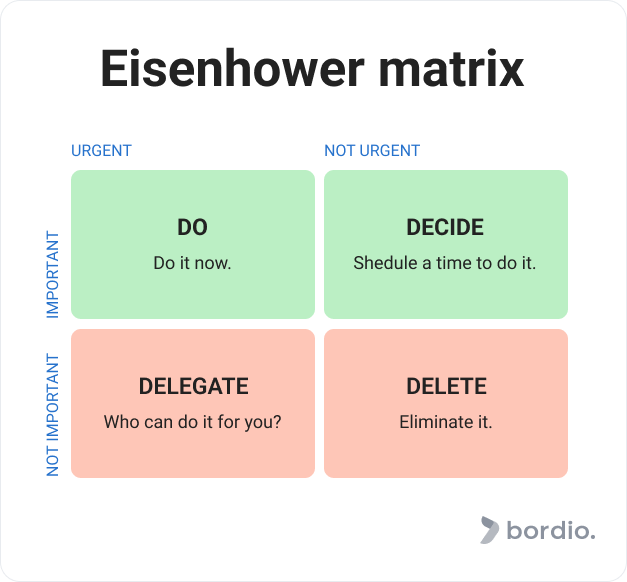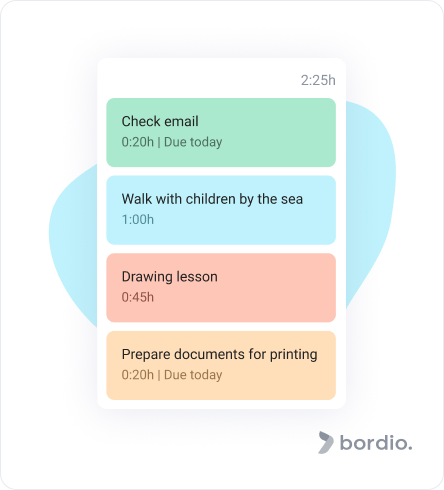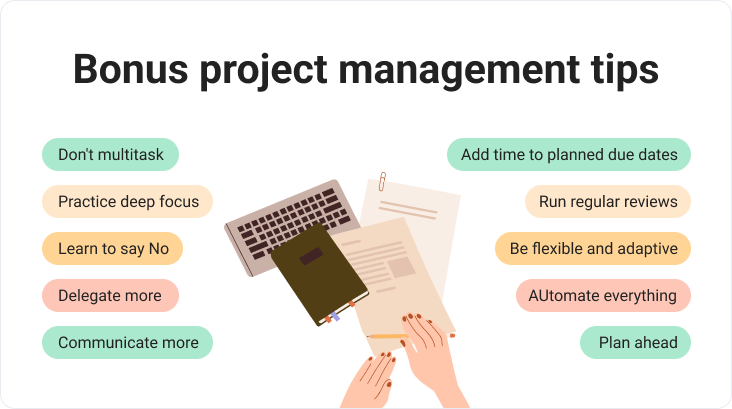Modern project managers (PMs) have many responsibilities and they are constantly juggling various roles and tasks within a project they manage.
On top of that, many PMs are also curating several projects at once!
And as we know, even one project takes tons of time, resources, and energy, so how do project managers manage to do it all and not go crazy? A lot of them use a combination of strategies and tricks that help them make time for everything and everyone.
In this article, we will share the steps to building a smart strategy for managing multiple projects, give you actionable tips, and, hopefully, help you to stay sane in the hectic world of project management.
Why is it important to strategize multiple project management?
Before we dive deep into the many strategies that exist for multiple project management, let’s go through the main reasons why one should spend their time working out a strategy, to begin with:
- A strategy helps meet project requirements and deliver results on time and within budget.
- Planning your time and strategizing reduce stress and anxiety. You know what is coming, what is required of you now, and everything is in order.
- Priorities are clear, and the workflow is organized most efficiently.
- It strengthens the project’s risk management. Risks are less likely to occur and shock us when we’ve planned everything out and designed a strategy for how to deal with uncertainties.
- You are better prepared for any changes that can happen unexpectedly. You can do it with handy task planner.
- Teams and stakeholders have better collaboration and trust through a clear communication plan.
Here are some of the challenges that you will avoid in managing multiple projects if you think and plan it in the free online planner beforehand:
- Inadequate resource allocation
- Issues with undefined task co-dependencies
- Unrealistic deadlines
- Conflicting priorities
Managing multiple tasks is not the same as managing multiple projects and managing time. It requires much more expertise and skills to excel in that kind of situation.
Building a strategy for successfully managing multiple projects
Now that we all agree that having strategies for managing several projects simultaneously is important, let’s look at the proven techniques to implement in your professional life.
Step 1: use a multi-project management solution
Use an online calendar planner software like Bordio with project management features that allows working with several projects at once. Then, create separate pages for each of the projects and upload anything related to it, such as:
- Project materials, e.g. project scope, milestones, and project objectives.
- All documents that were discussed and approved for the project.
- Full list of tasks and assignments.
- Visual tools like dashboards and graphs.
Let it be your single point of view. Share each page with the respective project team and stakeholders so that they can always access the project info. Plus, it can be your base for proper project reporting that project managers have to do either way. We also recommend daily schedule planner free and weekly schedule maker free by Bordio.
Why is it important to have single project info hubs? It adds transparency and acts as a motivational boost. Plus, if anyone needs to double-check some data, they can go to the project page, instead of requesting info from the project manager or other team members. It can seem insignificant, but in reality, it’s a huge time-saving.
Add colors for different task types in your schedule to add a little bit of gamification. Plus, you will be able to instantly spot what kind of work takes most of your time and what you should get on to first.
Program and project management go hand in hand, so utilize your solution and make the most of it!
Step 2: Prioritize tasks that deliver the most value and have the highest impact
Prioritization of the digital to-do list in your best task maker, is your secret to getting things done.
If you feel like every single task is urgent and important – it’s not. Trust us. You need to learn to identify what’s truly important and dedicate the most energy to it. Many project managers get stuck with routine tasks and miss out on strategic things. It’s not good because it results in poor team leadership and a higher failure rate for the projects.
We did a whole guide on task prioritization but if you have no time to dig deep into the topic (although we highly recommend doing this asap), start with the good old Eisenhower matrix that classifies tasks based on urgency and importance:
Step 3: Define as much as you can early on
The early stage is a dangerous spot for a project manager because they are tempted to skip the ‘boring’ part and move on to action sooner.
Yet, being meticulous at this stage can benefit project managers a lot. The more clarity you have at the beginning, the fewer risks and uncertainties you’ll face later when things get busy and crazy.
The minimum you need to figure out: expectations, goals, tasks, who’s in charge of what, roles in the team, and responsibilities.
Step 4: plan vigorously
You need to become a full-on planning guru! Create a separate plan and a schedule for each project and all project management process groups so that you can balance the time and energy, and maintain an intensive but sustainable pace.
Pro tip 1: Look across projects when planning the upcoming day and week – see how you can balance workload evenly.
Pro tip 2: Don’t plan back to back, so if something gets delayed or rearranged, your entire day won’t be ruined.
Step 5: implement time management techniques
Time management techniques seem to be endless which is great because anyone can find something that works for them.
For starters, try time blocking and time batching.
Time blocking is when you reserve a period of time to work on a specific task. Here is what it looks in Bordio:
Task batching is when you group similar tasks and do them one by one. For example, if you need to write 5 emails you can do that in one batch. It’s more effective this way because different kinds of tasks require a different mindset. For example, making a sales call, writing a report, and going on a meeting are all very different in terms of the energy that they take. Organizing your digital weekly planner like that would make you more productive with less effort.
Combine project process groups, like working on the final scope drafts, and see if it helps you work through the tasks faster and better.
Pro tip: Try time batching with a twist: spend each day working on a different project and only get distracted by other things if they’re minor. It is also very helpful for productivity, as you are fully immersed in the topic for the day, instead of jumping back and forth all the time.
Step 6: set milestones and keep them in one place
Set milestones in addition to goals and objectives for every project and have them all shown in one place. If you can, put them all in a single timeline.
Why should you do that? Two reasons: time management and stress management. You can see everything in one place and plan your time more efficiently. There are no surprises, so you can predict and prepare for all that’s coming.
Step 7: review, adapt, repeat
Keep on optimizing and improving your plans as you go.
Don’t fall for the dangerous assumption that you’re free to go once you’ve finished your initial planning and organizing. Every project management framework indicates that repetitive reviews and updates are key, and they have the reason to say that!
There are many vital PM skills out there, but perhaps the project manager’s ability to be relentlessly hands-on in change management, and never assume that yesterday’s tricks will do tomorrow, is their ticket to project management success.
Ps – if you’d like to learn more about the ABC’s of project management across different methodologies, feel free to check out the best project management books guide for inspiration.
Step 8: continuous learning and improving
Log your best practices and review what didn’t work to eliminate them in the future.
In Scrum there is an entire ceremony dedicated to this process called a sprint retrospective meeting where the team comes together to review the past couple of weeks’ worth of work. However, you can practice it with any other project management methodology.
There is no need to repeat the same mistakes over and over again, and it also makes sense to re-utilize whatever working mechanisms you’ve already created.
Step 9: build regular communication
Project communications are critical.
Plan weekly meetings with all project teams to track their progress for the previous week and align their tasks with big project plans for the upcoming week.
In addition to that, use those meetings to check in on everyone and don’t be shy to do little team-building activities, like virtual ice breakers.
Tips for managing several projects
Before we let you go and explore the beautiful world of managing projects at the same time, here are a few tips that we recommend you follow for the best results.
Don’t focus solely on project management competencies pertaining directly to the field. Work on skills and habits of a more general kind:
- No multitasking! No, seriously, it’s not working. Focus on one thing at a time, and you will see how much more productive and less stressed you become.
- Practice deep focus and avoid distractions. Turn off notifications and focus on one task for a fixed amount of time. Use timers or Pomodoro playlists for guided sessions.
- Learn to say No. Another golden rule that’s very hard to follow. You don’t win extra points for being a people pleaser but you will get overwhelmed and demotivated if you’re constantly being forced to do something you either have no time for or find utterly boring.
- Delegate more, regardless of your seniority. Anyone can delegate some of the tasks in their online daily planner. If you have junior staff who is eager to try new responsibilities – let them do it! For anything that cannot be outsourced to the team – find an assistant or a freelancer to work on. You can then monitor your work via remote collaboration software.
- Communicate at all times. The communication methods and frequencies you choose define your project’s success more than you think.
- Review progress regularly. You know how people with poor personal finance skills are afraid to check their balance because they fear what they can see there? You can be just like that but about your work. Don’t skip regular reviews and quick checks to see how well you’re doing. It can save you from deadline disasters and boost your motivation.
- Plan ahead. Review your week on Friday and prepare a plan for the next one. It can take 20-30 minutes of your time to review the tasks and do the planning. But the outcome will far outweigh the resources you’ve spent on planning. When you will start your working week, those first few hours won’t be spent on mindless email checks or distracted browsing. You will have things to do, and you will get right to it.
- Promote flexibility and adaptivity among your team members. It’s important that you, as a project manager, have a flexible and adaptive project management mindset but so has to be your team for you to sync. The reality of project management today is that things change in a blink of an eye, and you must be prepared for it.
- Automate what can be automated. There is no reason to do tasks manually if they can be conveniently automated. For example, use time management tools online to monitor your work.
- Add a bonus time to all your due dates. Let’s say a task needs to be completed by Wednesday – set the due date as Friday. Give yourself some space to breathe. It’s especially critical when you deal with many people in many different cases. There is always a risk of something slipping and not being done when you expect it. Don’t let that ruin your entire plan.

